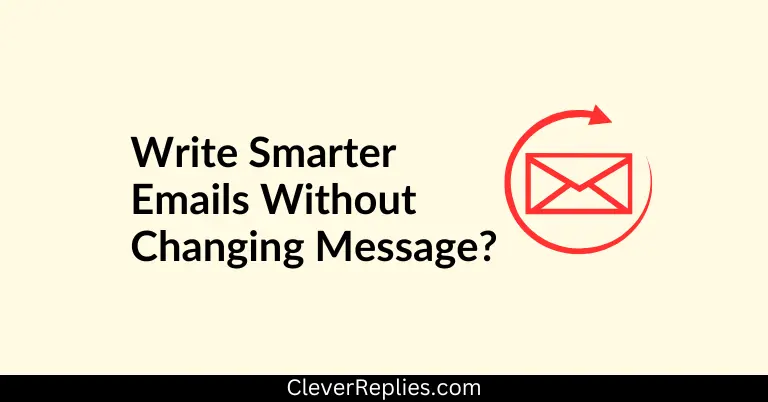How To Write Smarter Emails Without Changing Your Message? 8 Proven Ways
Just because an email isn’t working doesn’t mean the message itself is wrong. More often, the real issue lies in how it’s written.
It could be the wording, the tone, the structure, the length, or even how complicated the message feels.
You don’t always need to rewrite everything from scratch. Often, the smarter move is to keep the core message and reshape how it’s delivered.
That’s exactly what this guide will help you do.
I’ll walk you through practical, clear strategies to make your emails more effective—without changing what you actually want to say.
You’ll learn how to rewrite with purpose, sharpen your tone, and structure your message so it actually gets read and acted on.
Let’s get started.
Strengthen Your Subject Lines
A weak subject line is easy to ignore. A strong one gets your email opened.
Your first priority should be making your subject line clear, specific, and worth clicking. This will make sure that the recipient reads your message and takes action.
Here are some ways to write smarter subject lines:
1. Be clear and specific
Avoid vague or clever-sounding subject lines that say nothing. Your readers should know what the email is about before they even open it.
Instead of: “Check this out”
Say: “New Pricing Plans for Freelancers – Starting at $5”
2. Add a benefit or offer that matters
Make it obvious why someone should open the email. A subject line should hint at value, whether that’s a solution, an answer, or an incentive.
Instead of: “Our Weekly Newsletter”
Say: “Save 3 Hours a Week With These Writing Shortcuts”
3. Use power words if they fit the context
Words like free, limited, proven, or fast can boost open rates—but only when used honestly and in line with the email’s message. Avoid forcing them in just for effect.
Instead of: “Get Our Ebook”
Say: “Free Ebook: 10 Templates for Cold Emails That Get Replies”
4. Avoid misleading hooks
Don’t trick readers with clickbait. If your subject promises something your email doesn’t deliver, people may open it once—but they won’t trust you again.
Don’t say: “You’ve won a prize” (unless they really have)
Do say: “A Special Gift Inside for Our Loyal Subscribers”
5. Check how it looks on mobile
Most people will see your subject line on a phone, where space is limited. Keep it under 50 characters when possible and preview how it looks in different inboxes.
Bad: “Exclusive Invitation: Join Our Webinar and Learn How to Write Cold Emails That Get More Replies Than Ever Before”
Better: “Join Our Webinar: Write Cold Emails That Work”
Also Read: 55+ Ways To Respond to a Rejection Email (Best Examples)
Stay Focused And Cut Extra Things
Going off point or over-explaining weakens your email. Even a strong offer can be overlooked if the message feels too long or cluttered.
If your emails often feel wordy, trim the excess. Focus only on what helps the reader understand and take action.
Here’s how to keep your writing sharp:
• Use simpler words. Say “use” instead of “utilize,” “help” instead of “assist.”
• Remove filler phrases. Words like “just,” “actually,” or “in order to” often add nothing.
• Break down long sentences. Shorter sentences improve clarity and make the message easier to digest.
• Cut details that don’t support your point. If it doesn’t add value, delete it.
Clean writing gets read. But always check that your edits still preserve the main message.
Pay Close Attention To Wording
Sometimes, your message is right, but the way it’s written makes it hard to follow.
A few awkward words, technical terms, jargon, or complex structures can add to the difficulty of your email content.
So, if you find such words or sentences, try saying them in another yet engaging and understandable way.
However, most of the time, you know what to say but not how to say it clearly or engagingly. In such a situation where you feel stuck, try an AI-powered paraphrasing tool to explore better ways to say the same thing.
A paraphraser can not only help you overcome creative blocks but also incorporate simpler words and structures without changing your message.
Format Emails For Smart Scans
If your message is longer, don’t let it feel heavy. Most people scan emails before they decide whether to read them fully. If the initial glance shows value, they’ll keep going.
Structure your email so the key points are easy to spot, even without a full read.
Here’s how to make that happen:
• Keep sentences short and focused. Aim for one idea per sentence. Long blocks of text slow readers down.
• Use short paragraphs. Limit each paragraph to 2–3 lines max. It creates breathing room for the eyes.
• Break down lists or multiple points into bullets. Bullets help readers absorb information quickly.
• Add relevant visuals where needed. A simple image, chart, or screenshot can clarify your message and break up long sections of text.
Be Smart In Email Personalization
Another way to make your emails more effective is to add a personal touch to your emails.
Unlike many others who just think of personalization as addressing the recipients with their names, be creative and try new things.
But when personalizing, make sure that it doesn’t distract your readers from exactly what you want to say.
For example, you can review the previous data of the reader and adapt your tone accordingly.
Similarly, if you’re writing emails for e-commerce, you can mention their past purchases, clicks, add-to-carts, and other activities to add more relevance. The more your message feels relatable, the higher the chances of people taking action.
Ask For One Action At A Time
Email marketing is about guiding potential consumers through the entire buying journey. You can’t ask all things when the customer is at the learning or consideration stage.
If you do so, you actually confuse the readers. Sometimes, your content delivers the exact message you want to convey, but people fail to figure out what exactly you want them to do.
As a result, they just ignore your message and move forward. That’s why you must limit an email to only the most relevant action.
Check Your Emails’ Tone Before Sending
When aiming to polish emails without changing your message, you might adopt either a too-formal or a too-casual tone.
One makes your emails sound robotic, while the other gives a more careless or unprofessional feel. Remember, the key is to balance a friendly and a professional voice in emails. So, before sending them, analyze their tone deeply.
For this purpose, you should prefer to read the email content aloud for better understanding.
This way, your brain becomes smarter at catching awkward phrasing and weird sentences.
Consequently, you can better judge if your email sounds stiff or loose. This enables you to give a final writing touch to your message to make it feel natural and professional.
Also Read: Thank-You Email After Interview: What to Say + Examples
Final Take
You don’t need to change your message to write better emails. You just need to say it in a clearer, more effective way.
Use the tips above to improve how your emails look, sound, and get results. Small changes can make a big difference.

